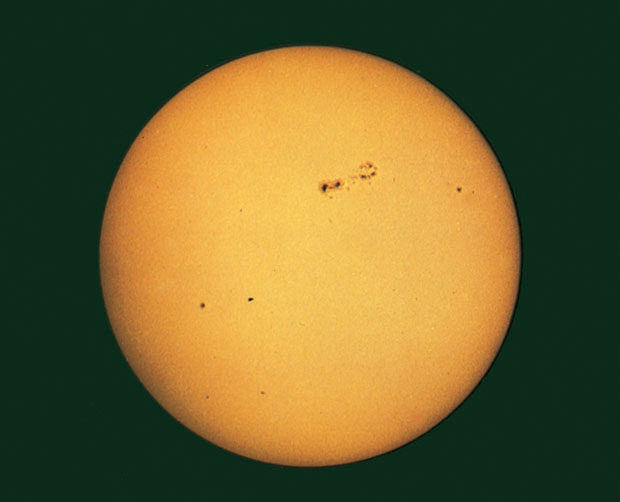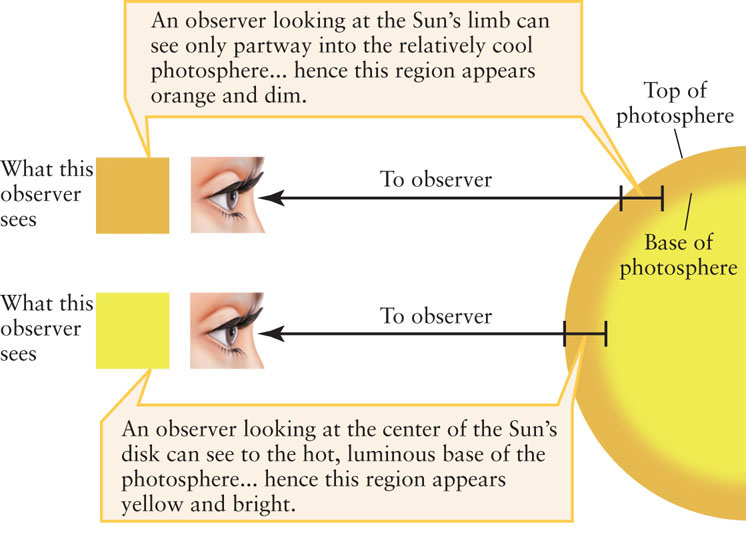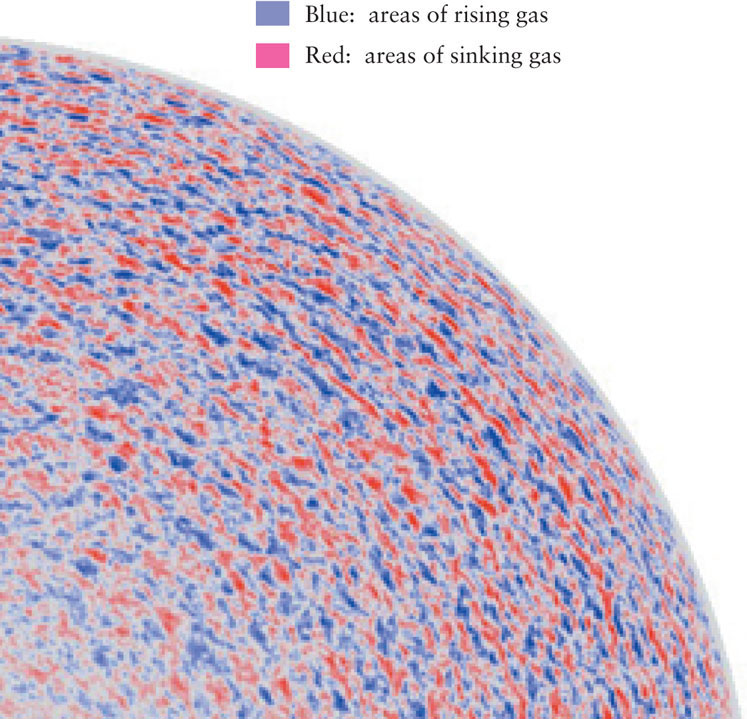16-5 The photosphere is the lowest of three main layers in the Sun’s atmosphere
Although the Sun’s core is hidden from our direct view, we can easily see sunlight coming from the high-temperature gases that make up the Sun’s atmosphere. These outermost layers of the Sun prove to be the sites of truly dramatic activity, much of which has a direct impact on our planet. By studying these layers, we gain further insight into the character of the Sun as a whole.
Observing the Photosphere

The Photosphere The photosphere is the layer in the solar atmosphere from which the Sun’s visible light is emitted. Note that the Sun appears darker around its limb, or edge; here we are seeing the upper photosphere, which is relatively cool and thus glows less brightly.(The dark sunspots, which we discuss in Section 16-8, are also relatively cool regions.)
A visible-light photograph like Figure 16-7 makes it appear that the Sun has a definite surface. This surface is actually an illusion; the Sun is gaseous throughout its volume because of its high internal temperature, and the gases simply become less and less dense as you move farther away from the Sun’s center.
Why, then, does the Sun appear to have a sharp, well-defined surface? The reason is that essentially all of the Sun’s visible light emanates from a single, thin layer of gas called the photosphere (“sphere of light”). Just as you can see only a certain distance through Earth’s atmosphere before objects vanish in the haze, we can see only about 400 km into the photosphere. This distance is so small compared with the Sun’s radius of 696,000 km that the photosphere appears to be a definite surface.
The photosphere is actually the lowest of the three layers that together constitute the solar atmosphere. Above it are the chromosphere and the corona, both of which are transparent to visible light. We can see them only using special techniques, which we discuss later in this chapter. Everything below the photosphere is called the solar interior.
The Lesson of Limb Darkening
The photosphere is heated from below by energy streaming outward from the solar interior. Hence, temperature should decrease as you go upward in the photosphere, just as in the solar interior (see Table 16-2 and Figure 16-3). We know this is the case because the photosphere appears darker around the edge, or limb, of the Sun than it does toward the center of the solar disk, an effect called limb darkening (examine Figure 16-7). This happens because when we look near the Sun’s limb, we do not see as deeply into the photosphere as we do when we look near the center of the disk (Figure 16-8). The high-altitude gas we observe at the limb is not as hot and thus does not glow as brightly as the deeper, hotter gas seen near the disk center.

The spectrum of the Sun’s photosphere confirms how its temperature varies with altitude. As we saw in Section 16-1, the photosphere shines like a nearly perfect blackbody with an average temperature of about 5800 K. However, superimposed on this spectrum are many dark absorption lines (see Figure 5-12). As discussed in Section 5-6, we see an absorption line spectrum of this sort whenever we view a hot, glowing object through a relatively cool gas. In this case, the hot object is the lower part of the photosphere; the cooler gas is in the upper part of the photosphere, where the temperature declines to about 4400 K. All the absorption lines in the Sun’s spectrum are produced in this relatively cool layer, as atoms selectively absorb photons of various wavelengths streaming outward from the hotter layers below.
CAUTION!
You may find it hard to think of 4400 K as “cool.” But keep in mind that the ratio of 4400 K to 5800 K, the temperature in the lower photosphere, is the same as the ratio of the temperature on a Siberian winter night to that of a typical day in Hawaii.
446
Granules and Supergranules in the Photosphere
We can learn still more about the photosphere by examining it with a telescope—but only when using special dark filters to prevent eye damage. Looking directly at the Sun without the correct filter, whether with the naked eye or with a telescope, can cause permanent blindness! Under good observing conditions, astronomers using such filter-equipped telescopes can often see a blotchy pattern in the photosphere, called granulation (Figure 16-9). Each light-colored granule measures about 1000 km (600 mi) across—equal in size to the areas of Texas and Oklahoma combined—and is surrounded by a darkish boundary. The difference in brightness between the center and the edge of a granule corresponds to a temperature drop of about 300 K.


 Solar Granulation High-resolution photographs of the Sun’s surface reveal a blotchy pattern called granulation. Granules are convection cells about 1000 km (600 mi) wide in the Sun’s photosphere. Inset: Rising hot gas produces bright granules. Cooler gas sinks downward along the boundaries between granules; this gas glows less brightly, giving the boundaries their dark appearance. This convective motion transports heat from the Sun’s interior outward to the solar atmosphere.
Solar Granulation High-resolution photographs of the Sun’s surface reveal a blotchy pattern called granulation. Granules are convection cells about 1000 km (600 mi) wide in the Sun’s photosphere. Inset: Rising hot gas produces bright granules. Cooler gas sinks downward along the boundaries between granules; this gas glows less brightly, giving the boundaries their dark appearance. This convective motion transports heat from the Sun’s interior outward to the solar atmosphere.
Like water boiling on a stove, the photosphere bubbles with convection cells
Granulation is caused by convection of the gas in the photosphere. The inset in Figure 16-9 shows how hot gas from lower levels rises upward in granules, cools off, spills over the edges of the granules, and then plunges back down into the Sun. Convection can occur only if the gas is heated from below, like a pot of water being heated on a stove (see Section 16-2). Along with limb darkening and the Sun’s absorption line spectrum, granulation shows that the upper part of the photosphere must be cooler than the lower part.
Time-lapse photography reveals more of the photosphere’s dynamic activity. Granules form, disappear, and reform in cycles lasting only a few minutes. At any one time, about 4 million granules cover the solar surface.
Superimposed on the pattern of granulation are even larger convection cells called supergranules (Figure 16-10). As in granules, gases rise upward in the middle of a supergranule, move horizontally outward toward its edge, and descend back into the Sun. The difference is that a typical supergranule is about 35,000 km in diameter, large enough to enclose several hundred granules. This large-scale convection moves at only about 0.4 km/s (1400 km/h, or 900 mi/h), about one-tenth the speed of gases churning in a regular-sized granule. A given supergranule lasts about a day.

Supergranules and Large-Scale Convection Supergranules display relatively little contrast between their center and edges, so they are hard to observe in ordinary images. But they can be seen in a false-color Doppler image like this one. Light from gas that is approaching us (that is, rising) is shifted toward shorter “bluer” wavelengths, while light from receding gas (that is, descending) is shifted toward longer “redder” wavelengths (see Section 5-9).
ANALOGY
Similar patterns of large-scale and small-scale convection can be found in Earth’s atmosphere. On the large scale, air rises gradually at a low-pressure area, then sinks gradually at a high-pressure area, which might be hundreds of kilometers away. This pattern is analogous to the flow in a supergranule. Thunderstorms in our atmosphere are small but intense convection cells within which air moves rapidly up and down. Like granules, they last only a relatively short time before they dissipate.
The Photosphere: Hot, Thin, and Opaque
Although the photosphere is a very active place, it actually contains relatively little material. Careful examination of the spectrum shows that it has a density of only about 10−24 kg/m3, roughly 0.01% the density of Earth’s atmosphere at sea level. The photosphere is made primarily of hydrogen and helium, the most abundant elements in the solar system (see Figure 8-4).
Despite being such a thin gas, the photosphere is surprisingly opaque to visible light. (This means that visible light is scattered numerous times as it passes through the photosphere.) If it were not so opaque, we could see into the Sun’s interior to a depth of hundreds of thousands of kilometers, instead of the mere 400 km that we can see down into the photosphere. What makes the photosphere so opaque is that its hydrogen atoms sometimes acquire an extra electron, becoming negative hydrogen ions. The scattering of photons can be pictured in two steps. In the first step, the extra electron of a negative hydrogen ion is only loosely attached and can be dislodged if it absorbs a photon of any visible wavelength. In the second step, a similar photon can be emitted when the dislodged electron once again combines with hydrogen to form another negative hydrogen ion, but the emitted photon heads in a random direction each time. Hence, negative hydrogen ions absorb light very efficiently, and there are enough of these light-absorbing ions in the photosphere to make it quite opaque. Because it is so opaque, the photosphere’s spectrum is close to that of an ideal blackbody (blackbodies are discussed in Section 5-3).
447
CONCEPT CHECK 16-11
What causes the photosphere to bubble like water boiling on the stove?